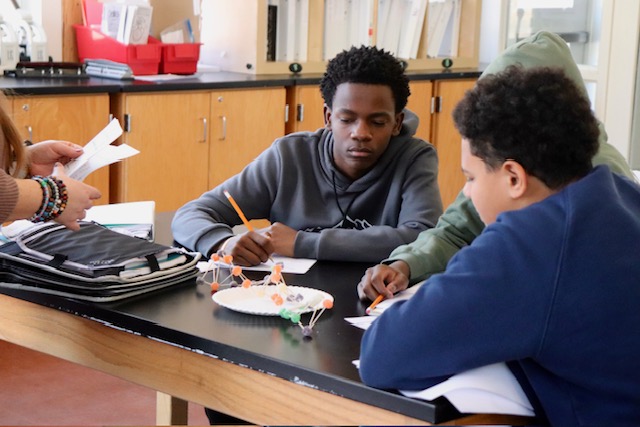
DNA Sequencing, Genetic Inheritance, and Gumdrops in 7th Grade Science with Angela Rohan
Just like knowing the color of your own eyes, once you learn about dominant and recessive traits in genetics, it’s hard to forget. There’s something fascinating about learning about how, even though humans are 99.99% the same, our unique genetic blueprint makes each person different. This concept was recently introduced in Angela Rohan’s 7th grade science class. Over the past few weeks, the 7th graders have been diving into the fundamental building blocks of the human genome: DNA, genetic code, and inherited genetics. They explored DNA’s double helix, examined dominant and recessive genes in Mendel’s Laws of Inheritance, and constructed their own gene by reading genetic code and building a double helix of DNA base pairs.
Beginning with the basics, the 7th graders explored the structure and function of DNA. They learned about the nucleotide base pairs that create DNA’s double helix structure—adenine (A), thymine (T), guanine (G), and cytosine (C)—and how the same two pairs always work together. In the following lesson, students studied how shorter segments of DNA are called genes, and each gene has a special code that determines a specific physical feature—or genotype—a living thing will have. To further understand this concept, the 7th graders studied Mendel’s Laws of Inheritance and examined his pea plant experiments that established the scientific framework for dominant and recessive inherited genetics.
To put their learning into action, Angela facilitated a project that brought everything together! Collaborating in small groups, the 7th graders were given an anonymous phenotype and, from a list of people, had to determine who it was by sequencing their DNA. Groupmates worked together to analyze the DNA base pair sequence of multiple genes. Then, after collecting several genotypes, cross-examined it with each character’s appearance to identify whose DNA they had. Afterward, they were tasked with constructing a 3D model of their characters’ DNA using different colored gumdrops (representing the four nucleotides) and toothpicks to build the double helix. Finally, they exchanged their models with another group and used that 3D code to interpret the traits of the other group’s character.

Located in College Park, MD, Friends Community School is a progressive Quaker K-8 day school, founded on the belief that every child is a valued member of our community. We offer a challenging curriculum imbued with strong values of equality, integrity, community, environmental stewardship, simplicity and peaceful conflict resolution, rooted in our Quaker heritage.
Friends Community School
5901 Westchester Park Drive
College Park, Maryland 20740
301-441-2100
5901 Westchester Park Drive
College Park, Maryland 20740
301-441-2100









